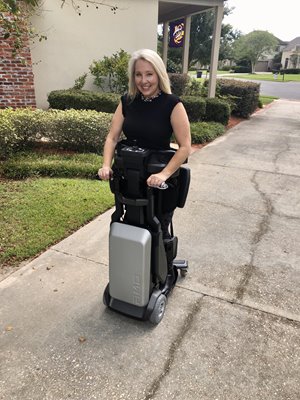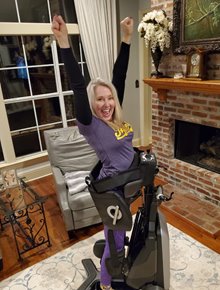
Did you know that our bodies were never designed to be in a seated position all day? It’s true! Our musculoskeletal, respiratory, digestive, and urinary systems all function optimally when we are standing.
The importance of standing for non-disabled people has been emphasized in the news for many years. However, the benefits of being vertical apply to ALL individuals, not only those who can stand independently.
There are several benefits to standing, but one of the most important ones is decreasing your chance of developing a pressure injury. When I tell my story with assisted standing, I share the risks of pressure injuries and how I combat them every day.
Bottom line is that no matter your ability, you need to stand as much as possible during the day to improve their health and longevity!
Health Benefits of Standing
There are numerous health benefits of standing for both non-disabled people and people with disabilities. Research shows that people who sit more during the day are at increased risk for obesity, cardiovascular disease, diabetes, back pain, and cancer. The advantages of standing include improved metabolism, a significant reduction in fatigue levels, increased productivity, and decreased risk of both diabetes and cancer.
For people with disabilities, there are tons of advantages to standing.
- Improved function in the home and community setting.
- Independence with medically related activities of daily living
- Improved kidney function and decreased urinary tract infections
- Improved gastrointestinal function.
- Decrease risk of impaction and bowel incontinence
- Improved bone density
- Reduced risk for pressure injury
- Improved self-esteem and social interaction
As mentioned above, a really important advantage of standing is decreasing your chance of developing a pressure injury. According to an article written by
Christian N. Kirman, MD, people with neurological impairment are at 25% to 85% risk for acquiring a pressure injury. Statistics also show that the cause of death for 7% to 8% of people with SCI is a pressure injury, and they are at 80% risk for recurrence.
My Standing Story
Remembering back to the first few weeks in the hospital after becoming paralyzed, all I wanted to do was stand up by any means possible. Although I would have loved to be able to stand unassisted, I knew that wasn’t an option.
My physical therapist, occupational therapist and nurses all taught me about the secondary illnesses that could happen to me because of my newly acquired spinal cord injury. The scariest of those complications was a pressure injury. If I did not do frequent pressure reliefs, wounds could happen in moments and could take months or years to heal.
Pressure injuries can cause sepsis, osteomyelitis, and in the most severe cases, death. I took those warnings very seriously and made it my mission never to allow a wound to develop. I was only nineteen years old, but I had lots of plans for the future, including college, a career, and, most importantly, parenthood. There was no room in my future for injury or frequent hospitalization.
I knew that it would be necessary to practice frequent pressure injury prevention in my wheelchair, but I also knew standing was vital. I advocated for braces to stand with and I stood as often as my therapist would allow me. I discovered
reciprocating gait braces (RGOs) and a standing power wheelchair that would both assist me in standing.
I used (and still use) a manual wheelchair, but my parents found a power chair with a standing feature that I could use at home when I didn’t have enough energy to handle the reciprocating gait braces.
Some of my doctors thought that I was too focused on standing. Some even thought the activity was only worth my time if I was going to walk again and believed I needed to get in my wheelchair and move on with my life.
I wasn’t in denial of my paralysis, but I knew the key to a long and healthy life was standing regularly. Standing also increased my independence and improved my psychological well-being. It always feels so good and as an added bonus, relieves my back pain. My favorite part is being able to see people eye to eye and getting a hug standing up – it’s the best feeling!
I am happy to report that after thirty-two years with a T10 complete spinal cord injury, I have stayed committed to standing as often as possible. I have never had a wound, bone fracture, or joint contracture in that entire time.
Types of Standing Devices
- Standing Frames. A static or dynamic device, which offers the individual the ability to make use of a tray or a platform that will hold a tablet or laptop computer. Others offer the option to do upper body exercises while standing.
- Standing robotic devices. These are standing devices on the market that are battery-powered and give a person the ability to be mobile in their homes while standing. Being mobile while standing improves the person's ability to complete functional tasks around the house.
- Exoskeletons. Battery-powered, externally worn walking devices. Some of these are only FDA approved for clinical use. Some are available for use at home or on the community, depending on the person's upper body mobility, strength, and overall endurance.
- Standing and seat elevation features that are built into a power wheelchair. People who require the use of power mobility can choose an option to have a seat elevation or standing feature added to the base of their wheelchair. These features usually must be features requested during the process of ordering a new power wheelchair.
Making a Stand
Implementing standing into your daily life can improve your physical and mental health in many ways. But first, you need to talk with a physician and clinical team in order to assess solutions for achieving a vertical posture best suited to your needs. It’s so important to be careful and follow the guidance ofyour healthcare professionals to ensure that you are safe to stand.
You may have to get creative in finding ways to fund standing devices, but it is well worth the effort. If you are receiving services from Vocational Rehabilitation in your state, ask your counselor about how standing could help you in your occupation. Many states have funds for people with disabilities that will pay for supported standing devices. Some companies that sell these standing devices also offer financing options.
Talking to clinicians, Assistive Technology Professionals (ATPs), social workers, and other wheelchair users will also help you discover funding sources that may be available to you. Each funding source has set criteria for accessing AT and standing technology.
Talk to as many people as possible about your desire to stand. Be persistent in your requests when attempting to acquire a standing device. Over the years of living with a disability, you will see the benefits of standing. Now go out and live your best life possible!